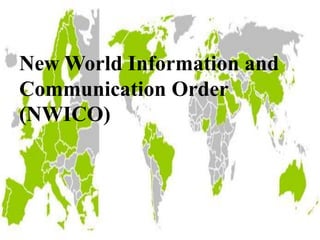
New world information and communication order
- 1. New World Information and Communication Order (NWICO)
- 2. Group members: Amber Ilyas Hina Nawab
- 3. “The Right to inform and be informed”
- 4. “New International Information Order” (NIIO) appeared during the 1970s as a result of what they perceived as their disadvantaged situation in the field of information and communication. Third World countries, encouraged by the movement of the Non-Aligned countries (NAM), protested against the global leadership of the Western news agencies (AP, AFP, UPI, and REUTER). These agencies were perceived as controlling up to 95 % of worldwide information flows.
- 5. The New World Information and Communication Order (NWICO) was younger sister to a 1974 UN-sponsored proposal for a New International Economic Order (NIEO). NWICO was created to foster more equitable communications between developed and developing worlds. NWICO was articulated through various forums during the 1970s, culminating with the 1980 United Nations Educational, Scientific and Cultural Organization (UNESCO) General Conference in Belgrade, which outlined the principles of NWICO
- 6. The World Summit on Information Society(WSIS) is the first event of its kind, within the United Nations, to deal with the issue of information in the digital era.
- 7. It took place in two phases: first in Geneva (2001-2003) then in Tunis (2003-2005). The complexity of the issues discussed transformed it into an ongoing process that will last until 2015, as the WSIS is supposed to contribute to the UN Millennium goals, especially development and the eradication of poverty and illiteracy.
- 8. The WSIS ended with the “Tunis Agenda”, a document that proposes ten priority lines of action for the issues that reached a consensus and the creation of a digital solidarity fund. As for the issues that failed to create a consensus, they are discussed in the Internet Governance Forum, a multi-stakeholder space for debate, without power of decision or recommendation.
- 9. NWICO and changing international communication paradigm: Significant changes in four major arenas of hard and soft power (Nye & Owens 1996; Cohen 1996). - Hard power refers to material forces such as military and economic leverage, while; - Soft power suggests symbolic forces such as ideological, cultural, or moral appeals.
- 10. Major changes seem to be taking place in both hard and soft power conceptions and calculations. First, information technologies have profoundly transformed the nature of military power because of emerging weapons systems dependent on laser and information processing. Second, satellite remote sensing and information processing have established an information power and deterrence analogous to the nuclear power and deterrence of an earlier era.
- 11. Third, global television communication networks such as CNN, BBC, and Star TV have added image politics and public diplomacy to the traditional arsenals of power politics and secret diplomacy. Fourth, global communication networks working through NGOs and interactive technologies such as the Internet are creating a global civil society and pressure groups that have served as new actors in international relations. Although no grand theoretical generalizations on the dynamics of hard and soft power are yet possible, trends indicate that the latter is assuming increasing importance.
- 12. History: The fundamental issues of imbalances in global communication had been discussed for some time. The American media scholar Wilbur Schramm noted in 1964 that the flow of news among nations is thin,. From a more radical perspective, Herbert Schiller observed in 1969 that developing countries had little meaningful input into decisions about radio frequency allocations for satellites at a key meeting in Geneva in 1963. Schiller pointed out that many satellites had military applications. Intelsat which was set up for international co-operation in satellite communication was also dominated by the United States.
- 13. New World Information Order or the New International Information Order Mass media concerns began with the meeting of non- aligned nations in Algiers, 1973; again in Tunis 1976, and later in 1976 at the New Delhi Ministerial Conference of Non-Aligned Nations. The 'new order' plan was textually formulated by Tunisia's Information Minister.
- 14. News reporting on the developing world that reflects the priorities of news agencies in London, Paris and New York. Reporting of natural disasters and military coups rather than the fundamental realities. An unbalanced flow of mass media from the developed world (especially the United States) to the underdeveloped countries. Advertising agencies in the developed world have indirect but significant effects on mass media An unfair division of the radio spectrum.
- 15. Issues: There were similar concerns about the allocation of the geostationary orbit (parking spots in space) for satellites. Satellite broadcasting of television signals into Third World countries Use of satellites to collect information The protection of journalists from violence was raised as an issue for discussion. For example, journalists were targeted by various military dictatorships in Latin America in the 1970s. As part of NWICO debates there were suggestions for study on how to protect journalists and even to discipline journalists who broke "generally recognized ethical standards". However, the MacBride Commission specifically came out against the idea of licensing journalists.
- 16. Response of US: The United States was hostile to NWICO. Barriers to the free flow of communication To the interests of American media corporations. Its disagreed with the McBride report NWICO as dangerous to freedom of the press
- 17. Conclusion: The relentless processes of historical and social change, the ambivalent commitment of international agencies to the new world order and the erstwhile efforts of private sector, non-governmental organizations can be conjoined to construct alternative structural possibilities and moral categories sufficient for a more encompassing and human context for the development, organization and uses of the new means of communication.
- 18. Thank you
